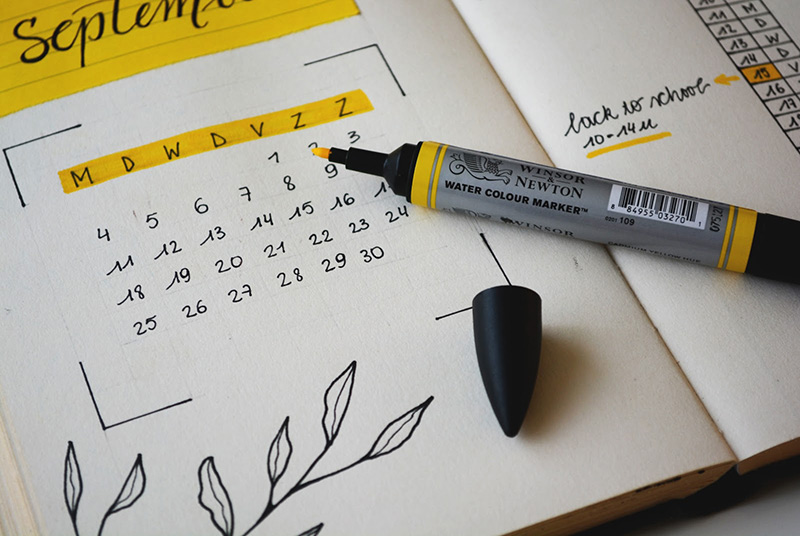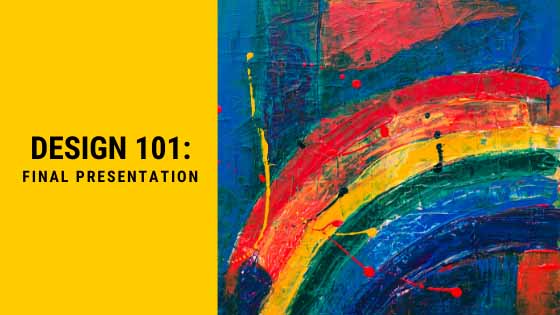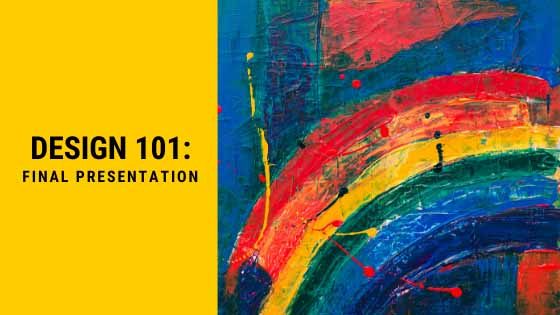A final design presentation is never an easy thing and should be taken as seriously as the designing process itself. How do you do it, though? We have answers, but first, let me introduce someone to you…
Table of contents:
Long Story Short
13:23 AM, 10 days ago, designer Jack just got the project from a new client.
C: “So, we are [insert any sphere] company, we are called [insert any name], and we need a new logo/banner/website design/etc. Money is not an issue, quality work is what matters for us. We do not have any exact idea of what we want, but we know you guys are pro’s, so we fully trust your creative decisions!”
J: “Now, that should be easy enough…”
10:40 PM, a week ago, the client’s first feedback.
C: “The first mockup is ok, but I’d like a different font, this one is just too much. And, also, change the colour of the background”
J: “What font? How exactly would you like to change it?”
C: “Just try something different. Could probably use some cold colours or whatever. I don’t like these ones”
11:25 AM, right before the presentation starts.
J: “Okay, I got this. Should be easy, the design looks good, hope the client will like it. He seems a bit annoying, though, but I worked hard on that one. Everything should be fine, don’t be so nervous…”
11:37 AM, right after the design presentation.
C: “You know, it looks fine, but I guess it would be great to add some green colour and change the font to something more pretty”
J: “But blue is, actually, better…”
C: “Honestly, I don’t really think so. I like green better. And what is that background? Why is it so dark? I want it a bit lighter, I don’t like dark tones”
J: “The background is dark because… uh, you know, nevermind. Tell me at least, what font would you like to have then?”
C: “I don’t know, just pick something prettier. Something that looks good, this one is too simple”
J: “I did just that after the previous review. Could you at least show me an example or give more details?”
C: “For God’s sake, you are a designer, why should I do it instead of you? Come up with something!”
Meet Jack

Oh, hello, my friend. How’s your life? I do hope you’re doing better than Jack. He’s a graphic designer, you know, and he got this project that seemed interesting and stuff, but, obviously, something went bananas. Frankly, not something – pretty much everything went bananas from the very beginning.
Ever been in Jack’s shoes, huh? If you’re here right now and you’re still reading this, I believe that you have. Jack is a good designer, he loves his job, he always does his best, but somehow he quite often finds himself in situations like this. And it’s not like the client is bad or anything – he just can’t explain his decisions properly. Some sort of communication glitch. Every time he goes to the presentation room, he feels that weird hook pulling up his stomach and his palms getting wet. He’s trying to calm down and persuade himself that this time, it’s gonna be different. Like, for sure. He did a good job and he knows it.
Well, don’t be Jack.
And I definitely don’t mean “don’t do a good job” – with this one you can, actually, follow his steps. It’s about hoping that it turns out just fine and that presentation doesn’t become a stand-up comedy show and float down the drain into the sewer *laughs in Pennywise*.
You don’t get to hope. You must be certain.
Why Is It Important?

Jack obviously didn’t get prepared for his presentation as he should have. He might be a good designer, but he’s not a really good lecturer. It might seem weird, but narration skills are something designers should practice regularly to talk to customers.
It is not exactly correct to think that clients usually don’t have an idea of what they want to see in the final mock-up. Whenever they come to check your work, they might have some remarks to make, right? Which kinda means that they could have some sort of image, but simply couldn’t explain what they wanted to get.
Are they to blame? No. YOU are the design expert, and YOU should be the smart guy in the room. When clients’ demands become weird and inconsistent it means the image of what they wanted to see initially wasn’t precise and could change in the project. And its designer or project manager’s job to make sure they are exact from the very beginning to ensure successful workflow. Failing to do that, creative teams often follow these inconsistent demands, and why? For the sake of getting the money and being done with it, even if the final draft is objectively not as good as it was supposed to be. And it’s just… meh.
Designer’s main task is solving the client’s business problem via graphic means, making the client’s product marketable. At the end of the day, it’s all about advertising and selling stuff. However, except for the client’s product, designers must also market themselves, and defending the final mockup in the presentation room is the pinnacle of self-promotion. Yet, as I’ve said, many designers neglect this part of the workflow.
The result?
It feels like you’re hitting a concrete wall with your head that you’ve built with your own hands. Lack of preparation causes stupor, anxiety, low confidence level, and lesser chances to get a testimonial or a recommendation, even if the final iteration satisfies the client. They will think that they were leading the project and you mostly did some mechanical work. Pressed a magical button that – *POOF* – created the design. Hocus-pocus. Unless you show them your perspective.
Avoiding Oopsies In Advance

It is much easier to work on design projects if you have a strictly developed workflow set from the very beginning. From our story, it is not really clear whether Jack had one or not, but I tend to think that he decided not to pay much attention to that. He might be used to working with clients who cannot provide clear and precise requirements and rely solely on magic spells, telepathy, and designer’s third inner eye. He thinks that, in the end, he can get away with whatever he creates, add it to his creative team’s portfolio if it comes up nice, and go to the pub to celebrate a successfully closed deal.
Does that look like a good workflow? I enjoy the ending, but, generally, I don’t think so.
Let me introduce a different model I would stick to:
- Make a clear brief. At the first meeting with the client, note down whatever information you can about the company you’re working with – you never know what you are about to use. Ask questions, as much as possible – they will help you to diagnose the problem, establish the final goal, understand what your client wants you to come up with. You need to get – even if it is very abstract – what is the idea your client wants to convey. If there’s none at all – keep pointing your gu… I mean, pencil on them until they tell you at least something. The information you’ll get will help you to…
- Carry out in-depth research. There is no way your decision can be based on your vague assumptions or personal opinion of your mother-in-law’s cousin’s son who once tried to design a logo for his Counter-Strike team back at high school. Every specific market has certain rules and tendencies, and you have to study them before you create the first draft.
- Gather feedback from your client all the way through. In order not to lose it and make it more specific and consistent, I’d suggest using some collaboration proofing software. It will also allow you tracking project history and all the actions within the project, which might help as well. Sometimes you have to remind your clients what their opinion on your ideas was several days ago. If you are using some proofing tool like Approval Studio, where every action is saved in the project history, it will make your life significantly easier.
The next and the last step of the workflow will be the presentation itself – the main reason why I made such a long and detailed prelude. Based on everything above, how do you prepare, what should you know, how should you behave, and what to answer?
Getting Ready To Rumble

So, the design is finished and you can’t help admitting it turned out pretty good. It corresponds with the market trends, provides a fresh idea, has a certain meaning and a message. Well done! But before you go to your troubled sleep to dream about more time for your troubled sleep, you have to make one last effort – prepare the presentation. Here is a simple formula:
- Go through the workflow from the very beginning. Check the brief and results of your market analysis first, and make the bullet-point list out of them (or, basically, anything you’ll be convenient working with, I don’t mind). That will help you significantly when you have to back up some of your moves and decisions.
- Gather client’s feedback. Do it regardless of how it influenced the final version or how it did not. Basing on your research and brainstorming, you will be able to explain which suggestions were worth including and which ones would only spoil the entire visual message, and why. The project report wouldn’t hurt as well – again, if you’re using proofing software like Approval Studio, it will be a matter of one click.
- Gather all key statistics or facts you used. Creating the mockup, you should always reference the source that made you make this or that decision as proof that you didn’t invent it and it has some reasoning. Backing up data with some authority will be useful.
- See to your strong and weak spots. Be objective and think about how you will address them. You have met the client several times or at least collaborated with them. Think of the questions they might ask you and come up with constructive answers. It will not let you be caught off guard and fall into a stupor.
- Prepare a step-by-step visual presentation. Show the versions changed, why they changed, and what the final result was. The format is up to you – video, slides, or whatever you feel more comfortable with and what works best for visual storytelling.
Remember about solid reasoning behind your every decision, every line, font change, color scheme choice. Your every move should be backed up by logic – this is what sound project management and professional design are all about. Build your presentation slides as a lecture where you explain your decisions and provide a valid argument for each of them. Use numbers, statistics, examples, bullet points – whatever you used when you were working on the design elements.
If you are working on your presentation in advance, it might be a good idea to practice and role-play it. Might be a fun way to have a party with your friends when all of your usual drinking games bore you to death. I call it a design-bingo: when you get a question that you can answer, the interviewer drinks. If you can’t reply or you are unsure of your answer– bottoms up for you. Just don’t do that right the day before your actual meeting. Defending your design after a hangover is not the Jedi way at all.
The Day “Z”

Ok, I ain’t gonna give you tons of advice based on different psychological tricks or whatever. I am a creative executive, not a psychologist, although it definitely wouldn’t hurt being one. Psychological skills, in fact, would help understand the client better and extract the much necessary information when you do the briefing, but the best strategy you can use at the presentation itself is being confident and keeping a smile on. Don’t overdo it, though. The main point is to make a good impression, not look like a weirdo.
However, there are some basics of psychology that you have to understand before you enter the meeting room. Your clients want to achieve the best result possible, and, providing they care about their business, they will surely be slightly opposed to your ideas and will look for any, even the smallest ones, misconceptions. Designer’s psyche is no different as well: you’ll try to protect your ideas whatever the cost, especially if you think that client’s remarks are somewhat insignificant.
To avoid smoke, you have to stick to the plan you have developed before and remember about logic. This is your main weapon. You might not like your design that much judging from your personal subjective taste and style, the client might not like it as well, but it is not a matter of your opinions. It is all about maximum efficiency. You are not an artist who creates for self-expression based on your own preferences – you are a mathematician who is here to prove that their formula works and can solve the problem.
So, be confident, don’t become overprotective, keep your smile on, and stick to the sound reasoning of your every step.
Done with subjectivity? Good, because I got something else for you:
- Begin with the general information about the project. Mention its problems and its goals. It will instantly become your fundament for all presentations. Focus on goals and on the way your ideas help reach them, not on the mockup itself.
- Be chronological. Explain your actions step-by-step and describe what influenced them – was it the client’s feedback, market analysis, or some statistic? Don’t be afraid to mention the hardships and questionable points. It will let your client see the whole scope of your work and appreciate it more.
- Use your evidence. Mention articles or other sources you’ve read or seen as references to prove the facts or statistics you based your decisions on.
- Be invested in your client’s suggestions, but ask for justification. Do you want a green color, different font, or lighter background? Fine, it sounds really interesting, but could you please explain why you would like to do so? How would it increase effectiveness? “I like it better” is not a proper answer, and you have to use your arguments to explain why.
- Never antagonize your client. Even if they back up their suggestion with evidence, getting overprotective of your work and emotional is the last thing you want to do. Provide your opinion, discuss both variants, and see which one would work better. If you are objectively wrong – accept it. There’s nothing shameful in constructive dialogue, it’s okay to be wrong sometimes and learn.
Remember that successful and friendly communication is the key to everything. Stay positive, don’t let your emotions take over, and always be rational. Who knows, you might earn yourself a returning client and significantly boost your reputation. It’s not only about helping the client market their stuff, it’s also about marketing your own skills and proficiency. And it is important.
At The End Of The Day
Well, I bet it was not easy, but I never doubted you could do a smashing presentation! Jack seems to be better off, too – he started using Approval Studio review tool for improved feedback and communication, managed to explain to his client that darker background provides more contrast to the image, the blue color is used by 33% of companies in their logos and is favored by 57% of men and 35% of women, and Comic Sans font is… well… ehhh…
Okay, I admit Jack still has something to learn. But it’s never too late, right?

 TEAM SOLUTIONS
TEAM SOLUTIONS WORKFLOW SOLUTIONS
WORKFLOW SOLUTIONS



 REVIEW TOOL
REVIEW TOOL PROJECT MANAGEMENT
PROJECT MANAGEMENT TOOLS & INTEGRATIONS
TOOLS & INTEGRATIONS
 CLIENT INTERVIEWS
CLIENT INTERVIEWS









